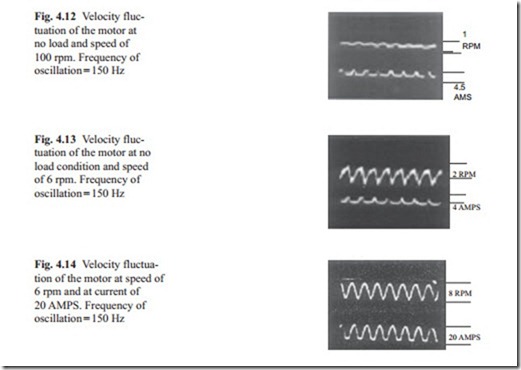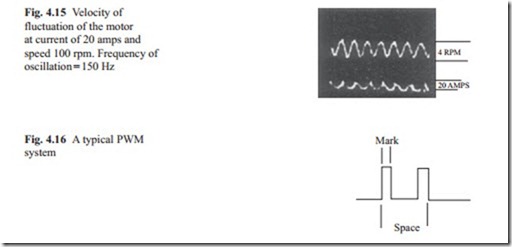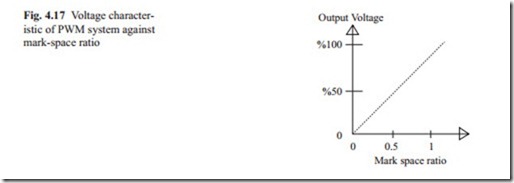Effect of Form Factor on Speed Fluctuation
A test rig was setup several years ago to test the performance of Thyristor controlled DC servo motors. A 2 kW DC motor was connected to a loading mechanism so that the motor can be tested at several applied torque. The controller consisted of three phase power supply with Thyristors to rectify the voltage in positive direction con- nected to the motor to rotate clockwise direction and negative rectification for the motor to rotate in counter clockwise direction. The circuit of the controller had a lead-lag network to improve the performance. The firing angle was controlled from the output of lead-lag network with another electronic controlled circuit. A tacho
meter was attached to the end of motor, which is a small DC motor, to produce a negative velocity feedback to improve the performance by enabling the loop gain to be increased for higher accuracy. A Resolver was also attached to the other end of loading mechanism to measure the rotor displacement. Resolver is simply a motor which produces two sinusoidal signal with phase difference proportional to rotor displacement. So the motor was able to be controlled in position or velocity of the motor. Discussion of the electronics is beyond the scope of the book.
The purpose of adding this section is to investigate the speed fluctuation of the motor as firing angle changes.
The motor was first run at relatively high speed with no load which means when the fluctuation of speed is minimum. This is shown below that at speed 100 rpm and current of 4.5 amps the speed fluctuation become 1 rpm (Fig. 4.12).
The figure below shows the case when no load is applied to the motor and the motor is run at 6 rpm. The current drawn from the system is 4 AMPS. The speed fluctuation of speed is relatively small.
Figure 4.13 shows the case when no load is applied to the motor and the motor is run at 6 rpm. The current drawn from the system is 4 AMPS. The speed fluctuation of speed is relatively small.
Then the fluctuation of speed was observed at high current when the load is applied to the motor. Figure below shows the fluctuation of speed at a current of 20 AMPS and rotational speed of 6 rpm (Fig. 4.14).
It can be seen that at a speed of 6 rpm the fluctuation of the actual rotor is 8 rpm and the current drawn from the system is 20 AMPS.
Next experiment was conducted when the motor was run at relatively high speed (100 rpm) and the current from the motor was 20 AMPS. Figure 4.15 shows the response of velocity fluctuation and the shape of the current.
It can be seen that three is speed fluctuation at all speed and current. The worst condition is when the motor run at slow speed and high current. To reduce the speed of fluctuation at low firing angle the thyristors are fired at both directions i.e. it produces current at both direction and this gives a position or velocity stiffness. The Thyristor controlled DC voltage at three phase power supply the fluctuation is very small.
For very high performance application Pulse Width Modulation (PWM) tech- nique can be used. In this case the three phase power supply is rectified with full wave rectification. The output DC voltage is then controls the average output volt- age. The output variable voltage is in the form of square pulses where the electron- ics in the drive controls the mark space ratio which determines the average output voltage. This is graphically shown below, (Fig. 4.16).
The mark space ratio is determined by the drive unit and the frequency of pulses can be as high as 2 kHz. This minimizes the fluctuation of the speed considerably in fact it is negligible. Figure below shows the average voltage against the mark space ratio. It can be seen that the average voltage is a straight line which means the system has a constant gain. This kind of drive is suitable for position control applications (Fig. 4.17).
In the design of power supply one should consider that whether the small fluc- tuation can be tolerated or not. If it is acceptable one should purchase Thyristor controlled drive unit because it is cheaper. If it is not acceptable PWM drive is the best choice. As the performance improves the drive becomes more expensive. The overall cost depends on the number of axes to be driven and whether the position must be controlled or the position of output.
In selecting a DC motor for specific application several factors must be considered. The DC motor studied in this chapter was an example how to use numerical values in the system model. Sometimes the inductance can be ignored but for closed loop control it must be considered. The motor studied in this chapter was a permanent magnet and the voltage was connected to the armature through a pair of brushes. The permanent magnet has great influence on the performance of DC mo- tor and it becomes smaller when the rare earth magnet is used. The brushes cause some reliability problem and to overcome this problem brushless DC motor can be designed.
The information one must obtain is the torque and velocity constant, in addition the rated and maximum starting torque are some important parameters even though they are not considered. The maximum starting torque determines the initial acceleration of the rotor and any inertia attached to the motor. The electronics circuit must be designed in such a way to limit the maximum current passes through the armature windings to avoid the windings from burning. This also determines the maximum output torque of the motor which must be operated for a short period of time. The rated torque can be operated continuously without worrying about the above mentioned problem. There are three types of drive unit for DC motor. One is a single phase thyristor controlled drive unit which is relatively cheap to buy but the problem of speed fluctuation should be tolerated. This type of drive is suitable for low performance applications and it can be used both for position and velocity control. It cannot produce great position/velocity stiffness against the external torque. The frequency of output pulses is 50 Hz for bidirectional application or 100 Hz for one direction only. The second type of drive unit is three phase Thyristor controlled system which can produce output pulse frequency of 150 Hz for bidirectional applications and 300 Hz for one direction rotating speed. The second type is much better than the first one because the fluctuation of speed is greatly reduced. The third type is PWM type which is more expensive than the first two types because the three phase power supply has to be rectified. After rectification for small motor power transistors can be used to generate square wave form. The frequency of pulse could be greater than 2 kHz which is sufficiently great to reduce the speed fluctuation to a negligible value. For motor with power greater that a fraction of KW Thyristors are used to generate the square pulses. The problem with Thyristors is that once they
are fired they continue to conduct until the current becomes zero. This is achieved by special circuitry design which allow the current becomes zero momentarily and again they are fired at the right moment.



